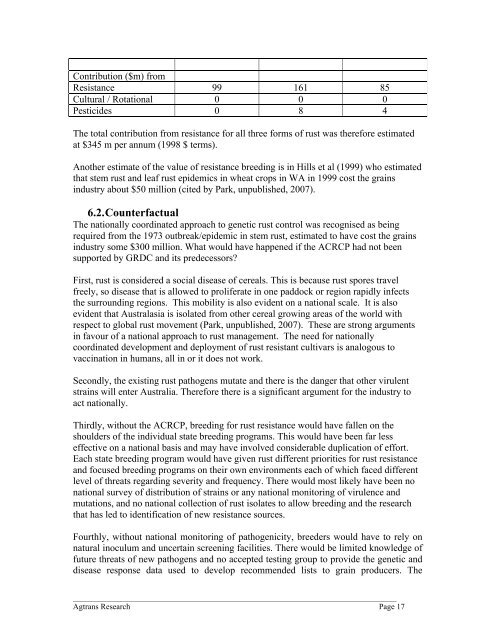An Economic Analysis of GRDC Investment in the - Grains Research ...
An Economic Analysis of GRDC Investment in the - Grains Research ...
An Economic Analysis of GRDC Investment in the - Grains Research ...
Create successful ePaper yourself
Turn your PDF publications into a flip-book with our unique Google optimized e-Paper software.
Contribution ($m) from<br />
Resistance 99 161 85<br />
Cultural / Rotational 0 0 0<br />
Pesticides 0 8 4<br />
The total contribution from resistance for all three forms <strong>of</strong> rust was <strong>the</strong>refore estimated<br />
at $345 m per annum (1998 $ terms).<br />
<strong>An</strong>o<strong>the</strong>r estimate <strong>of</strong> <strong>the</strong> value <strong>of</strong> resistance breed<strong>in</strong>g is <strong>in</strong> Hills et al (1999) who estimated<br />
that stem rust and leaf rust epidemics <strong>in</strong> wheat crops <strong>in</strong> WA <strong>in</strong> 1999 cost <strong>the</strong> gra<strong>in</strong>s<br />
<strong>in</strong>dustry about $50 million (cited by Park, unpublished, 2007).<br />
6.2. Counterfactual<br />
The nationally coord<strong>in</strong>ated approach to genetic rust control was recognised as be<strong>in</strong>g<br />
required from <strong>the</strong> 1973 outbreak/epidemic <strong>in</strong> stem rust, estimated to have cost <strong>the</strong> gra<strong>in</strong>s<br />
<strong>in</strong>dustry some $300 million. What would have happened if <strong>the</strong> ACRCP had not been<br />
supported by <strong>GRDC</strong> and its predecessors?<br />
First, rust is considered a social disease <strong>of</strong> cereals. This is because rust spores travel<br />
freely, so disease that is allowed to proliferate <strong>in</strong> one paddock or region rapidly <strong>in</strong>fects<br />
<strong>the</strong> surround<strong>in</strong>g regions. This mobility is also evident on a national scale. It is also<br />
evident that Australasia is isolated from o<strong>the</strong>r cereal grow<strong>in</strong>g areas <strong>of</strong> <strong>the</strong> world with<br />
respect to global rust movement (Park, unpublished, 2007). These are strong arguments<br />
<strong>in</strong> favour <strong>of</strong> a national approach to rust management. The need for nationally<br />
coord<strong>in</strong>ated development and deployment <strong>of</strong> rust resistant cultivars is analogous to<br />
vacc<strong>in</strong>ation <strong>in</strong> humans, all <strong>in</strong> or it does not work.<br />
Secondly, <strong>the</strong> exist<strong>in</strong>g rust pathogens mutate and <strong>the</strong>re is <strong>the</strong> danger that o<strong>the</strong>r virulent<br />
stra<strong>in</strong>s will enter Australia. Therefore <strong>the</strong>re is a significant argument for <strong>the</strong> <strong>in</strong>dustry to<br />
act nationally.<br />
Thirdly, without <strong>the</strong> ACRCP, breed<strong>in</strong>g for rust resistance would have fallen on <strong>the</strong><br />
shoulders <strong>of</strong> <strong>the</strong> <strong>in</strong>dividual state breed<strong>in</strong>g programs. This would have been far less<br />
effective on a national basis and may have <strong>in</strong>volved considerable duplication <strong>of</strong> effort.<br />
Each state breed<strong>in</strong>g program would have given rust different priorities for rust resistance<br />
and focused breed<strong>in</strong>g programs on <strong>the</strong>ir own environments each <strong>of</strong> which faced different<br />
level <strong>of</strong> threats regard<strong>in</strong>g severity and frequency. There would most likely have been no<br />
national survey <strong>of</strong> distribution <strong>of</strong> stra<strong>in</strong>s or any national monitor<strong>in</strong>g <strong>of</strong> virulence and<br />
mutations, and no national collection <strong>of</strong> rust isolates to allow breed<strong>in</strong>g and <strong>the</strong> research<br />
that has led to identification <strong>of</strong> new resistance sources.<br />
Fourthly, without national monitor<strong>in</strong>g <strong>of</strong> pathogenicity, breeders would have to rely on<br />
natural <strong>in</strong>oculum and uncerta<strong>in</strong> screen<strong>in</strong>g facilities. There would be limited knowledge <strong>of</strong><br />
future threats <strong>of</strong> new pathogens and no accepted test<strong>in</strong>g group to provide <strong>the</strong> genetic and<br />
disease response data used to develop recommended lists to gra<strong>in</strong> producers. The<br />
________________________________________________________________________________<br />
Agtrans <strong>Research</strong> Page 17

















